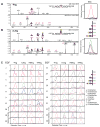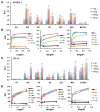Deciphering the Fringe-Mediated Notch Code: Identification of Activating and Inhibiting Sites Allowing Discrimination between Ligands
- PMID: 28089369
- PMCID: PMC5263050
- DOI: 10.1016/j.devcel.2016.12.013
Deciphering the Fringe-Mediated Notch Code: Identification of Activating and Inhibiting Sites Allowing Discrimination between Ligands
Abstract
Fringe proteins are β3-N-acetylglucosaminyltransferases that modulate Notch activity by modifying O-fucose residues on epidermal growth factor-like (EGF) repeats of Notch. Mammals have three Fringes: Lunatic, Manic, and Radical. While Lunatic and Manic Fringe inhibit Notch1 activation from Jagged1 and enhance activation from Delta-like 1, Radical Fringe enhances signaling from both. We used a mass spectrometry approach to determine whether the variable effects of Fringes on Notch1 result from generation of unique glycosylation patterns on Notch1. We found that Lunatic and Manic Fringe modified similar sites on Notch1, while Radical Fringe modified a subset. Fringe modifications at EGF8 and EGF12 enhanced Notch1 binding to and activation from Delta-like 1, while modifications at EGF6 and EGF36 (added by Manic and Lunatic but not Radical) inhibited Notch1 activation from Jagged1. Combined, these results suggest that Fringe modifications "mark" different regions in the Notch1 extracellular domain for activation or inhibition.
Keywords: EGF repeats; Fringe; Notch; O-fucose; development; glycosylation; signal transduction.
Copyright © 2017 Elsevier Inc. All rights reserved.
Figures




Similar articles
-
Fringe glycosyltransferases differentially modulate Notch1 proteolysis induced by Delta1 and Jagged1.Mol Biol Cell. 2005 Feb;16(2):927-42. doi: 10.1091/mbc.e04-07-0614. Epub 2004 Dec 1. Mol Biol Cell. 2005. PMID: 15574878 Free PMC article.
-
Modulation of the NOTCH1 Pathway by LUNATIC FRINGE Is Dominant over That of MANIC or RADICAL FRINGE.Molecules. 2021 Sep 30;26(19):5942. doi: 10.3390/molecules26195942. Molecules. 2021. PMID: 34641486 Free PMC article.
-
Fringe-mediated extension of O-linked fucose in the ligand-binding region of Notch1 increases binding to mammalian Notch ligands.Proc Natl Acad Sci U S A. 2014 May 20;111(20):7290-5. doi: 10.1073/pnas.1319683111. Epub 2014 May 6. Proc Natl Acad Sci U S A. 2014. PMID: 24803430 Free PMC article.
-
Regulation of intrathymic T-cell development by Lunatic Fringe- Notch1 interactions.Immunol Rev. 2006 Feb;209:76-94. doi: 10.1111/j.0105-2896.2006.00360.x. Immunol Rev. 2006. PMID: 16448535 Review.
-
Regulation of Notch signaling during T- and B-cell development by O-fucose glycans.Immunol Rev. 2009 Jul;230(1):201-15. doi: 10.1111/j.1600-065X.2009.00791.x. Immunol Rev. 2009. PMID: 19594638 Review.
Cited by
-
Notch Signaling-Induced Oscillatory Gene Expression May Drive Neurogenesis in the Developing Retina.Front Mol Neurosci. 2019 Sep 19;12:226. doi: 10.3389/fnmol.2019.00226. eCollection 2019. Front Mol Neurosci. 2019. PMID: 31607861 Free PMC article.
-
O-fucosylation stabilizes the TSR3 motif in thrombospondin-1 by interacting with nearby amino acids and protecting a disulfide bond.J Biol Chem. 2022 Jun;298(6):102047. doi: 10.1016/j.jbc.2022.102047. Epub 2022 May 18. J Biol Chem. 2022. PMID: 35597280 Free PMC article.
-
Synergistic effects of mutation and glycosylation on disease progression.Front Mol Biosci. 2025 Feb 4;12:1550815. doi: 10.3389/fmolb.2025.1550815. eCollection 2025. Front Mol Biosci. 2025. PMID: 39967653 Free PMC article. Review.
-
FUT10 and FUT11 are protein O-fucosyltransferases that modify protein EMI domains.Nat Chem Biol. 2025 Apr;21(4):598-610. doi: 10.1038/s41589-024-01815-x. Epub 2025 Jan 7. Nat Chem Biol. 2025. PMID: 39775168 Free PMC article.
-
Decoding the PTM-switchboard of Notch.Biochim Biophys Acta Mol Cell Res. 2019 Dec;1866(12):118507. doi: 10.1016/j.bbamcr.2019.07.002. Epub 2019 Jul 11. Biochim Biophys Acta Mol Cell Res. 2019. PMID: 31301363 Free PMC article. Review.
References
-
- Benedito R, Roca C, Sorensen I, Adams S, Gossler A, Fruttiger M, Adams RH. The notch ligands Dll4 and Jagged1 have opposing effects on angiogenesis. Cell. 2009;137:1124–1135. - PubMed
-
- Bruckner K, Perez L, Clausen H, Cohen S. Glycosyltransferase activity of Fringe modulates Notch-Delta interactions. Nature. 2000;406:411–415. - PubMed
MeSH terms
Substances
Grants and funding
LinkOut - more resources
Full Text Sources
Other Literature Sources
Molecular Biology Databases

